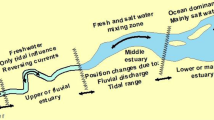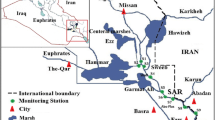Abstract
A numerical hydrodynamic modelling study has been implemented based on the seasonal salinity variations in a networked system (comprising creek and an estuary), which is the first of its kind attempted for the Indian subcontinent. Salinity variations in the estuaries and creeks exhibited unique characteristics caused by the combined effects of various external forces such as tidal flow, freshwater runoff, wind and geometric effects. Precise understanding of dynamical conditions in estuaries and creeks is necessary to address pertinent issues related to oceanography, water quality and ecosystem dynamics. In a broader perspective, it is noted that due to the influence of winds during monsoon, the salinity fields in the estuarine environment are not in a steady state. However, in creeks, tidal flow plays a major role in altering the salinity structure apart from runoff. The results from this study decipher the fact that the networked system was vertically homogenous during all seasons. However, a horizontal salinity gradient was observed in the system depending on the river runoff. The flushing time for the Ulhas estuary was about 1.5 and 2.57 days during the monsoon and non-monsoon seasons, respectively. Similarly, for the Thane creek, tide-driven flushing time was about 3.68 days. The low flushing time during the wet season provides a suitable dynamic environment for effluent discharge in the mid and upstream reaches of the estuary, wherein the freshwater influx is higher. On the contrary, during the dry season over this region, the low runoff and the highest flushing times can increase the pollution or can support the growth of phytoplankton biomass accumulation.
















Similar content being viewed by others
References
Akter R, Asik T Z, Sakib M, Akter M, Sakib M N, Al Azad A S M A, Maruf M, Haque A and Rahman Md M 2019 The dominant climate change event for salinity intrusion in the GBM delta; Climate 7(69), https://doi.org/10.3390/cli7050069.
Anonymous 2015 Comprehensive Study on Polluted River Stretch of Ulhas River – Downstream of Mohane Kalyan, Maharashtra Pollution Control Board, Kalyan, https://www.mpcb.gov.in/sites/default/files/focus-area-reports-documents/UlhasRiverReport.pdf.
Athalye R P 2013 Biodiversity of Thane creek; In: National conference on biodiversity: Status and challenges in conservation FAVEO, pp. 9–14.
Bárcena J F, García A, Gómez A G, Álvarez C, Juanes J A and Revilla J A 2012 Spatial and temporal flushing time approach in estuaries influenced by river and tide. An application in Suances estuary (northern Spain); Estuar. Coast. Shelf Sci. 112 40–51, https://doi.org/10.1016/j.ecss.2011.08.013.
Chen X and Zong Y 1999 Major impacts of sea-level rise on agriculture in the Yangtze delta area around Shanghai; Appl. Geogr. 19 69–84, https://doi.org/10.1016/s0143-6228(98)00035-6.
Dabrowski T, Hartnett M and Olbert A I 2010 Influence of seasonal circulation on flushing of the Irish Sea; Mar. Pollut. Bull. 60 748–758, https://doi.org/10.1016/j.marpolbul.2009.11.018.
Deltares 2018 Delft3D-Flow simulation of multi-dimensional hydrodynamic flows and transport phenomena including sediments; Delft.
Devkota B H and Imberger J 2009 Lagrangian modeling of advection‐diffusion transport in open channel flow; Water Resour. Res. 45(12) W12406 (1–14).
Dinesh Kumar P K and Sarma R V 1991 Flushing characteristics of Amba river estuary west coast of India; Indian J. Mar. Sci. 20 212–215.
Eaton T T 2007 Analytical estimates of hydraulic parameters for an urbanized estuary – Flushing bay; J. Hydrol. 347 188–196, https://doi.org/10.1016/j.jhydrol.2007.09.018.
Egbert G D, Bennett A F and Foreman M G 1994 TOPEX/POSEIDON tides estimated using a global inverse model; J. Geophys. Res.: Oceans 99(C12) 24,821–24,852.
Geyer W R, Trowbridge J H and Bowen M M 2000 The dynamics of a partially mixed estuary; J. Phys. Oceanogr. 30 2035–2048, https://doi.org/10.1175/1520-0485(2000)030<2035:tdoapm>2.0.co;2.
Gupta I, Dhage S, Chandorkar A A and Srivastav A 2004 Numerical modeling for Thane creek; Env. Model. Softw. 19 571–579, https://doi.org/10.1016/j.envsoft.2003.07.005.
Hansen D V and Rattray M 1966 New dimensions in estuary classification; Limnol. Oceanogr. 11 319–326, https://doi.org/10.4319/lo.1966.11.3.0319.
Hu K, Ding P, Wang Z and Yang S 2009 A 2D/3D hydrodynamic and sediment transport model for the Yangtze estuary, China; J. Mar. Syst. 77 114–136, https://doi.org/10.1016/j.jmarsys.2008.11.014.
Huang W 2007 Hydrodynamic modeling of flushing time in a small estuary of north Bay Florida USA; Estuar. Coast. Shelf Sci. 74 722–731, https://doi.org/10.1016/j.ecss.2007.05.016.
Jubin T, Velamala S N and Prasad K V S R 2019 Numerical simulation of tidal constituents in Thane creek and the Ulhas estuary, west coast of India; J. Coast. Res. 35 376, https://doi.org/10.2112/jcoastres-d-17-00189.1.
Kuang C, Jiang M, Huang J and Gu J 2011 Numerical simulation of impact of the upstream discharge on salinity at Qingcaosha reservoir; In: 2011 second international conference on mechanic automation and control engineering, IEEE, pp. 2334–2337.
Lesser G R, Roelvink J A, van Kester J A T M and Stelling G S 2004 Development and validation of a three-dimensional morphological model; Coast. Eng. 51 883–915, https://doi.org/10.1016/j.coastaleng.2004.07.014.
Liu W C, Hsu M H, Kuo A Y and Kuo J T 2001 The influence of river discharge on salinity intrusion in the Tanshui estuary, Taiwan; J. Coast. Res. 17(3) 544–552.
Longfei Y and Johnson J A 1994 Models of Kelvin tidal waves in the Lingdingyang region Pearl river estuary south China; Estuar. Coast. Shelf Sci. 38 291–299, https://doi.org/10.1006/ecss.1994.1020.
Monsen N E, Cloern J E, Lucas L V and Monismith S G 2002 A comment on the use of flushing time residence time and age as transport time scales; Limnol. Oceanogr. 47 1545–1553, https://doi.org/10.4319/lo.2002.47.5.1545.
Moore J and Ramamurthy S 1984 Heavy metals in natural waters; Springer Verlag, New York.
Naidu V S and Sarma R V 2001 Numerical modeling of tide-induced currents in Thane creek west coast of India; J. Waterw. Port Coast. Ocean Eng. 127 241–244, https://doi.org/10.1061/(asce)0733-950x(2001)127:4(241).
Pickett P J 1997 Lower Skagit river total maximum daily load water quality study, Washington Department of Ecology Olympia, WA 97326.
Purnachandra Rao V, Shynu R, Kessarkar P M, Sundar D, Michael G S, Narvekar T, Blossom V and Mehra P 2011 Suspended sediment dynamics on a seasonal scale in the Mandovi and Zuari estuaries central west coast of India; Estuar. Coast. Shelf Sci. 91 78–86, https://doi.org/10.1016/j.ecss.2010.10.007.
Qiu C and Zhu J R 2013 Influence of seasonal runoff regulation by the Three Gorges reservoir on saltwater intrusion in the Changjiang river estuary; Cont. Shelf Res. 71 16–26, https://doi.org/10.1016/j.csr.2013.09.024.
Rathod S, Patil N N, Quadros G and Athalye R P 2002 Qualitative study of fin fish and shellfish fauna of Thane creek and Ulhas river estuary; In: Proceedings of national seminar on creeks estuaries and mangroves: Pollution and conservation, Thane, Vol. 1, pp. 135–141.
SatheeshKumar J and Balaji R 2015 Inter-comparison of hydrodynamic models of Gulf of Khambhat; Int. J. Ocean Clim. Syst. 6 35–46, https://doi.org/10.1260/1759-3131.6.1.35.
Seena G, Muraleedharan K R, Revichandran C, Abdul Azeez S and John S 2019 Seasonal spreading and transport of buoyant plumes in the shelf off Kochi southwest coast of India – A modeling approach; Sci. Rep. 9, https://doi.org/10.1038/s41598-019-56103-9.
Senthilnathan S and Balasubramaniam T 1998 Heavy metal concentration in oyster Crassastreamadrasensis (Bivalvia/Arisomyaria) from Uppanar Vellar and Kaduviar estuaries of south-east coast of India; Ind. J. Mar. Sci. 27 211–216.
Shaha D C, Cho Y K, Kwak M T, Kundu S R and Jung K T 2011 Spatial variation of the longitudinal dispersion coefficient in an estuary; Hydrol. Earth Syst. Sci. 15 3679–3688, https://doi.org/10.5194/hess-15-3679-2011.
Sheldon J E and Alber M 2002 A comparison of residence time calculations using simple compartment models of the Altamaha river estuary Georgia; Estuaries 25 1304–1317, https://doi.org/10.1007/bf02692226.
Sundar D, Unnikrishnan A S, Michael G S, Kankonkar A, Nidheesh A G and Subeesh M P 2015 Observed variations in stratification and currents in the Zuari estuary west coast of India; Env. Earth Sci. 74 6951–6965, https://doi.org/10.1007/s12665-015-4702-2.
Swart R L 2015 Salinity intrusion and tidal propagation in estuarine channel networks with different channel lengths. An idealised model study using Delft3D; Master’s thesis.
Trouw K, Zimmermann N, Mathys M, Delgado R and Roelvink D 2012 Numerical modelling of hydrodynamics and sediment transport in the surf zone: A sensitivity study with different types of numerical models; Coast. Eng. Proc. 1(33) 23.
Vijith V, Sundar D and Shetye S R 2009 Time-dependence of salinity in monsoonal estuaries; Estuar. Coast. Shelf Sci. 85 601–608, https://doi.org/10.1016/j.ecss.2009.10.003.
Werner A D and Lockington D A 2006 Tidal impacts on riparian salinities near estuaries; J. Hydrol. 328 511–522, https://doi.org/10.1016/j.jhydrol.2005.12.011.
Zarzuelo C, López-Ruiz A, Díez-Minguito M and Ortega-Sánchez M 2017 Tidal and subtidal hydrodynamics and energetics in a constricted estuary; Estuar. Coast. Shelf Sci. 185 55–68, https://doi.org/10.1016/j.ecss.2016.11.020.
Zhang E, Savenije H H G, Wu H, Kong Y and Zhu J 2011 Analytical solution for salt intrusion in the Yangtze estuary, China; Estuar. Coast. Shelf Sci. 91 492–501, https://doi.org/10.1016/j.ecss.2010.11.008.
Acknowledgements
The authors are grateful to scientist-in-charge and director, CSIR-National Institute of Oceanography, India, for their constant encouragement and support during the study. Also, the authors acknowledge the Maharashtra Maritime Board for providing bathymetry maps of the Thane creek and the Ulhas estuary.
Author information
Authors and Affiliations
Contributions
JT and VSN collected data and processed it. JT carried out the model experiment and wrote the original draft. PRS, PB and CVN helped in manuscript writing and its review. All authors read and approved the manuscript.
Corresponding author
Additional information
Communicated by C Gnanaseelan
Rights and permissions
About this article
Cite this article
Thomas, J., Naidu, V.S., Shanas, P.R. et al. Influence of river inflow and its impact on the salinity variations and flushing time in a networked system, northwest coast of India. J Earth Syst Sci 131, 90 (2022). https://doi.org/10.1007/s12040-022-01837-w
Received:
Revised:
Accepted:
Published:
DOI: https://doi.org/10.1007/s12040-022-01837-w




